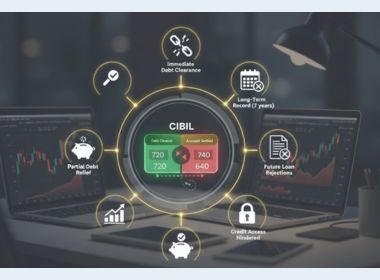Search Suggestions
- Gold Loan
- Money Transfer
- Mutual Funds

What is IDV in Vehicle Insurance & How is It Calculated?
Vehicle insurance policies are undoubtedly full of terms and phrases that most people find difficult to understand. However, to ensure a hassle-free experience with any insurer, it is crucial for all policyholders to thoroughly understand the policy they plan to buy, so they can be sure they are making the right decision. A very common term that you may have come across in your four- or two-wheeler insurance, is IDV. The IDV is a very important component in any vehicle insurance, as it not only affects the premium you pay but also your claim experience.
But what is this IDV in your insurance policy? How is IDV calculated? What role does it play in coverage?
These questions may have crossed your mind at some point. But don’t worry; here is a small guide to explain what an IDV is and to take you through everything else you need to know about the term.
What is IDV?
The full form of IDV in insurance is ‘Insured Declared Value’. This value is the maximum amount of money (or sum assured) that an insurer will offer a claimant in certain situations when the vehicle is a total loss. In simple words, it is your vehicle’s present market value. This means that the IDV dictates the maximum compensation you can get under the policy’s coverage. That is why it is very important to ensure that you choose the right IDV in your insurance policy.
But, if the IDV is the market value of the vehicle, why would a policyholder need to choose an IDV?
Declaring IDV in Insurance Policies
The current market value of your vehicle is calculated based on the selling price that is listed by the manufacturer (for your particular model and variant, including the cost of any added accessories), which is then adjusted for depreciation (based on the vehicle’s age).
However, the Insured ‘Declared’ Value allows for a little flexibility in vehicle insurance; meaning that an IDV can be ‘declared’ by the owner, where you can declare a lower IDV for your vehicle as well.
Choosing Lower IDV in Vehicle Insurance
In two-wheeler and car insurance, low IDV translates to lower premiums – a choice opted for by many policyholders. As the maximum sum assured will be lower in such a case, you will be required to pay a smaller premium for the coverage as well. However, it will also increase the risk for you as the maximum pay-out you get if your vehicle is declared a total loss also depends on what IDV is listed in your insurance policy. So, a lower IDV, means a lower sum assured and higher loss if something untoward were to happen.
It is generally recommended to choose an IDV that is close to the current market value of the vehicle.
How is IDV Calculated?
A number of factors are taken into consideration when a vehicle’s IDV is calculated, like how old the vehicle is, the variant you own, whether there are added accessories, and so on. However, basic formulae can be used to get an idea of your vehicle’s IDV:
-
Without Accessories IDV = Ex-Showroom Price of the Vehicle - Depreciation
-
With Accessories IDV = [Ex-Showroom Price of the Vehicle - Depreciation] + [Price of Accessories – Depreciation]
Factors that Affect Calculation of IDV in Car/Two-Wheeler Insurance
-
Type of Vehicle: The calculated IDV in two-wheeler insurance will obviously be less than the IDV in car insurance. So, the type of vehicle, whether it’s a truck, taxi, personal car, two-wheeler, etc., is the biggest aspect that defines the IDV.
-
Vehicle Segment: An SUV will have a higher value than a sedan, while a sedan will be priced higher than a hatchback. Same with two-wheelers; sport bikes are priced higher than street bikes, which are priced higher than gearless scooters. So, the type of vehicle is one of the foremost factors to be considered when calculating IDV in an insurance policy.
-
The Brand and Model: The resale value of the brand and its reputation in the market will also affect the value of the vehicle. For example, a luxury car will have a higher IDV than an entry-level car, even if they are in the same segment. The price will also vary with the model of the car.
-
Age and Depreciation: One of the most important factors in IDV calculation for insurance, total depreciation is calculated based on how old a vehicle is and subtracted from its listed selling price.
-
Location: As the ex-showroom price of vehicles may vary from city to city, where your vehicle is registered is also an important factor. Regardless of where you bought it, it is the place of registration that will be taken into consideration in IDV calculation for the insurance.
The Rate of Depreciation
The value of any vehicle reduces by a certain percentage every passing year. This is known as depreciation. The depreciation rate for vehicles, both cars and bikes, has been specified by the Insurance Regulatory and Development Authority of India (IRDAI), which is used to determine the IDV for car and bike insurance in India.
| Depreciation Rates for Vehicles | ||
|---|---|---|
| Age of Vehicle | Depreciation | |
| 6 Months and Less | 5% | |
| 6 Months – 1 Year | 15% | |
| 1 Year – 2 Years | 20% | |
| 2 Years – 3 Years | 30% | |
| 3 Years – 4 Years | 40% | |
| 4 Years – 5 Years | 50% | |
| More than 5 Years | Mutually Decided b/w Insurer and Insured | |
Once the vehicle crosses the 5-year mark, the IDV will have to be mutually agreed upon by the policyholder and the insurance company.
In What Situations is the IDV Payable?
In vehicle insurance, IDV-related claims are quite rare, but they do happen. The most major of losses are covered by the IDV in vehicle insurance and in such situations, fair compensation is always appreciable for the policyholder.
-
Theft: The most common of claims in vehicle insurance, where IDV is payable. Theft is a total loss for the owner, which means that the insurer is liable to compensate the policyholder for the current market value of the vehicle to offset the financial impact of the incident. This is also one of the reasons why many insurers offer reduced premiums for vehicles that have been fitted with safety accessories, alarms, security systems, etc.
-
Total Loss: Total loss is another situation covered by vehicle insurance where the IDV is payable. In the automobile sector, total loss refers to a car being damaged beyond repair or when the cost of repairs exceeds the market value of the vehicle, making it pointless to try and fix it. In insurance, 75% of the IDV is generally considered as the limit; and if the cost of repairing the vehicle crosses this limit, the vehicle is written off as a total loss and the policyholder is paid the total sum assured mentioned in the insurance (IDV). The damage could be a result of an accident, man-made calamities like riots, or an Act of God like an earthquake or flood.
Now, armed with the knowledge of what significance the IDV holds in insurance, you can make an informed decision when it comes to choosing the right insurance policy and IDV for your vehicle to ensure comprehensive coverage. While a lower IDV, with lower premiums, may seem lucrative at first glance, a higher IDV offers enhanced protection in the long run. However, you should consider your own needs and requirements and choose an IDV that suits you.
At Muthoot Finance, you can get the right car insurance advice and buying options through Muthoot Insurance Brokers Pvt. Ltd., a 100% subsidiary company of the brand. Walk into your nearest Muthoot Finance branch to speak to our insurance experts.
- Insurance
- Group Insurance
- Health Insurance
- Home Insurance
- Vehicle Insurance
- Life Insurance
- Travel Insurance
- Shop Insurance
CATEGORIES
OUR SERVICES
-

Credit Score
-

Gold Loan
-

Personal Loan
-

Cibil Score
-

Vehicle Loan
-

Small Business Loan
-

Money Transfer
-

Insurance
-

Mutual Funds
-

SME Loan
-

Corporate Loan
-

NCD
-

PAN Card
-

NPS
-

Custom Offers
-

Digital & Cashless
-

Milligram Rewards
-

Bank Mapping
-

Housing Finance
-

#Big Business Loan
-

#Gold Loan Mela
-

#Kholiye Khushiyon Ki Tijori
-

#Gold Loan At Home
-

#Sunherisoch
RECENT POSTS

Understanding KDM Gold and Why it’s Banned
Know More
How BNPL Affects Your Credit Score
Know More
What is a Cheque and its Different Types in India?
Know More
Benefits of Paying Your EMIs on Time: Why Timely Payments Matter
Know More
A Complete Guide to Report Online Fraud
Know More
How does a Personal Loan Affect your Credit Score?
Know More
Gilt Fund vs Liquid Fund: Full Form, Meaning & SIP Guide
Know More
XIRR in Mutual Funds & SIP: Full Form, Meaning, Formula and How to Calculate
Know More
7 Key Factors to Consider Before Taking an SME Loan
Know More
Difference Between Black Gold and Gold: Everything You Need to Know
Know MoreFIN SHORTS

What Are Co-Pay and Deductibles in Insurance Policies?
Know More
Should You Take a Loan Against Your Mutual Fund or SIP?
Know More
Top 5 Best Mid-Cap Mutual Funds to Watch in 2026
Know More
Are Personal Loans Right for Retirees? Key Points to Consider
Know More
What Happens to a Personal Loan After the Borrower Dies?
Know More
Best Loan Choices for Credit Scores of 580 and Below
Know More
7 Reasons Why a Gold Loan Is the Best Option for Small Businesses
Know More
10 Reasons Why People in India Prefer Physical Gold
Know More
Real Estate vs Gold: Which Is a Better Investment in India?
Know More
10 Common Mistakes That Make Investors Lose Money in Mutual Funds
Know More
10 Reasons Why Gold Has So Much Appeal in Uncertain Times
Know More
7 Ways Settling Debt Can Impact Your CIBIL Score
Know More- South +91 99469 01212
- North 1800 313 1212





